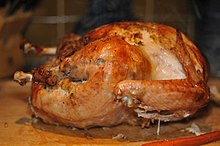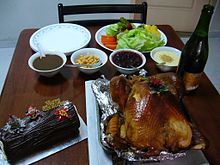Turkey meat
This article possibly contains original research. (February 2015) |

Turkey meat, commonly referred to as just turkey, is the
Preparation and production

Turkeys are sold sliced and ground, as well as "whole" in a manner similar to
A large amount of turkey meat is processed. It can be smoked, and as such, is sometimes sold as
Unlike
Cultural traditions

Turkeys are traditionally eaten as the main course of
Turkey meat has been eaten by indigenous peoples from Mexico, Central America, and the southern tier of the United States since antiquity. In the 15th century, Spanish conquistadores took Aztec turkeys back to Europe.[9]
Turkey was eaten in as early as the 16th century in England.[10] Before the 20th century, pork ribs were the most common food for the North American holidays, as the animals were usually slaughtered in November. Turkeys were once so abundant in the wild that they were eaten throughout the year, the food considered commonplace, whereas pork ribs were rarely available outside of the Thanksgiving–New Year season.[11] While the tradition of turkey at Christmas spread throughout Britain in the 17th century,[10] among the working classes, it became common to serve goose, which remained the predominant roast until the Victorian era.[12]
Turkey with mole is regarded as Mexico's "national dish".[13][14]
Because the turkey is a
Cooking
| Nutritional value per 100 g (3.5 oz) | |
|---|---|
| Energy | 465 kJ (111 kcal) |
0 g | |
| Sugars | 0 g |
| Dietary fiber | 0 g |
0.7 g | |
24.6 g | |
Niacin (B3) | 41% 6.6 mg |
| Pantothenic acid (B5) | 14% 0.7 mg |
| Vitamin B6 | 35% 0.6 mg |
| Folate (B9) | 2% 8 μg |
| Vitamin C | 0% 0 mg |
| Minerals | Quantity %DV† |
| Calcium | 1% 10 mg |
| Iron | 7% 1.2 mg |
| Magnesium | 7% 28 mg |
| Phosphorus | 16% 206 mg |
| Potassium | 10% 293 mg |
| Sodium | 2% 49 mg |
| Zinc | 11% 1.2 mg |
| Other constituents | Quantity |
| Water | 74 g |
| †Percentages estimated using US recommendations for adults,[18] except for potassium, which is estimated based on expert recommendation from the National Academies.[19] | |
Turkeys are usually baked or roasted in an oven for several hours, often while the cook prepares the remainder of the meal. Sometimes, a turkey is brined before roasting to enhance flavor and moisture content. This is done because the dark meat requires a higher temperature to denature all of the myoglobin pigment than the white meat (very low in myoglobin), so that fully cooking the dark meat tends to dry out the breast. Brining makes it possible to fully cook the dark meat without drying the breast meat. Turkeys are sometimes decorated with turkey frills, paper frills or "booties" that are placed on the end of drumsticks or bones of other cutlets.[20][21]
In some areas, particularly the American South, they may also be deep fried in hot oil (often peanut oil) for 30 to 45 minutes by using a turkey fryer. Deep frying turkey has become something of a fad, with hazardous consequences for those unprepared to safely handle the large quantities of hot oil required.[22]

Nutrition
When raw, turkey breast meat is 74% water, 25%
.A 100 gram amount of turkey breast contains 279 mg of
| Meat | Protein (100 g) |
|---|---|
| Salami | 13.0 |
Pork sausages (grilled)
|
13.3 |
| Ground beef | 23.1 |
| Roast chicken | 24.8 |
| Grilled lean, back bacon | 25.3 |
| Roast turkey | 25.0 |
Accompaniments

For
For Christmas in the United Kingdom, turkey is traditionally served with winter vegetables, including roast potatoes, Brussels sprouts, and parsnips. Cranberry sauce is the traditional condiment in the northern rural areas of the United Kingdom where wild cranberries grow. In the south and in urban areas, where cranberries until recently were difficult to obtain, bread sauce was used in its place, but the availability of commercial cranberry sauce has seen a rise in its popularity in these areas, too.[citation needed] Pigs in blankets, a dish consisting of small sausages (usually chipolatas) wrapped in bacon are a popular and traditional accompaniment.[26][27][28][29][30]
Especially during holiday seasons around Thanksgiving and Christmas,
See also
References
- ^ Slater, Jack (18 December 2022). "What's the difference between turkey crowns, ballotines and bronze turkeys?". Metro. Retrieved 23 December 2022.
- ^ "How to cook a turkey crown". BBC Good Food. Retrieved 23 December 2022.
- ^ "Why do turkeys have dark and white meat?". loc.gov. Library of Congress. Archived from the original on 9 June 2015. Retrieved 6 June 2015.
- ^ "Publication of an application for registration pursuant to the second subparagraph of Article 8(1) of Council Regulation (EEC) No 2082/92 on certificates of specific character (98/C 405/06)". European Union. Archived from the original on 24 October 2021. Retrieved 16 January 2022.
- ^ Barrie, Josh (17 August 2020). "Turkey Twizzlers: A complete history of the controversial Bernard Matthews product – and what the new 'healthy' recipe tastes like". The i. Archived from the original on 3 September 2021. Retrieved 3 September 2021.
- ^ Adams, Cecil (6 March 1998). "Why can't you buy turkey eggs in stores?". The Straight Dope. Archived from the original on 11 August 2020. Retrieved 25 November 2010.
- ^ Kasey-Dee Gardner (18 November 2008). "Why? Tell Me Why!: Turkey Eggs". DiscoveryNews. Archived from the original on 27 November 2012. Retrieved 25 November 2010.
- History, A+E Networks, archivedfrom the original on 21 January 2018, retrieved 12 November 2017
- from the original on 25 January 2021. Retrieved 29 September 2020.
- ^ a b Davis, Karen (2001) More than a meal: the turkey in history, myth, ritual, and reality Archived 2019-06-07 at the Wayback Machine Lantern Books, 2001
- ASIN B000UIRZVE.
- ^ A Victorian Christmas Archived 2012-01-30 at the Wayback Machine Historic UK.com Retrieved December 26, 2010
- ^ Karen Hursh Graber (1 January 2003). "Demystifying Mole, México's National Dish". exConnect. Archived from the original on 20 February 2019. Retrieved 20 August 2010.
- ^ "Travelfoodanddrink.com". travelfoodanddrink.com. Archived from the original on 17 February 2020. Retrieved 3 May 2014.
- ^ "Turkey and rice a hit at borough chief's eatery". Taiwan Today. 27 July 2007. Retrieved 27 August 2022.
- ^ Wei, Clarissa (11 December 2020). "From roadside eatery to big city darling: How one Taiwanese turkey rice vendor made it big". CNN Travel. Retrieved 27 August 2022.
- ^ Rabbi Ari Z. Zivotofsky. "Is turkey kosher?". kashrut.com. Retrieved 13 June 2023.
- ^ United States Food and Drug Administration (2024). "Daily Value on the Nutrition and Supplement Facts Labels". Retrieved 28 March 2024.
- )
- ^ "FAQs". Eatturkey.com. Archived from the original on 30 September 2011. Retrieved 18 October 2011.
- ^ "Does Turkey Really Make You Sleepy After Eating? – Zidbits – Learn something new everyday!". Archived from the original on 1 December 2020. Retrieved 24 August 2015.
- Underwriters Laboratories. Archived from the originalon 25 April 2009. Retrieved 21 December 2007.
- ^ "Turkey, fryer-roasters, breast, meat only, raw". USDA Nutrient Database. Archived from the original on 24 September 2020. Retrieved 28 April 2013.
- ^ Korb, Alex (21 November 2011). "The Turkey-Tryptophan Myth". Psychology Today. Retrieved 30 January 2020.
- ^ "Researcher talks turkey on Thanksgiving dinner droop". Massachusetts Institute of Technology News Office. Archived from the original on 23 July 2013. Retrieved 21 November 2006.
- ^ Lee, Jeremy (26 November 2017). "The great Christmas taste test 2017". The Guardian. Retrieved 4 January 2018.
- ^ "Everything you want to know about pigs in blankets". Erudus. 2 December 2021. Retrieved 21 October 2022.
- ^ Thompson, Rachel (24 December 2018). "I ate 100 different 'pigs in blankets' at a sausage party and it was painfully delicious". Mashable. Retrieved 21 October 2022.
- ^ Neild, Barry (14 December 2013). "Turkey, pigs in blankets, even sprouts… but no Christmas pudding, thanks". The Observer. Retrieved 4 January 2018.
- ^ "Classic pigs in blankets". BBC Good Food. Retrieved 21 October 2022.
External links
 Media related to Turkey meat at Wikimedia Commons
Media related to Turkey meat at Wikimedia Commons


